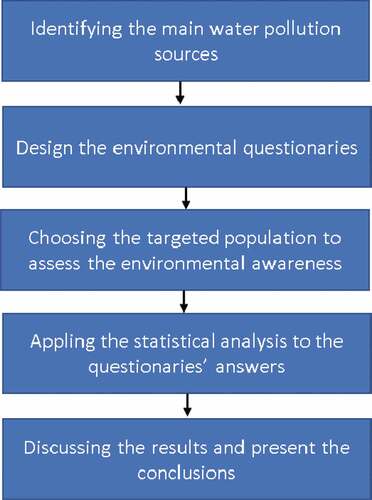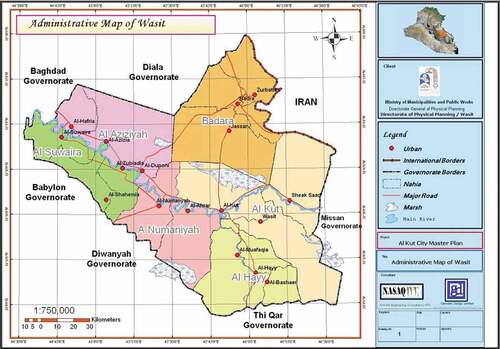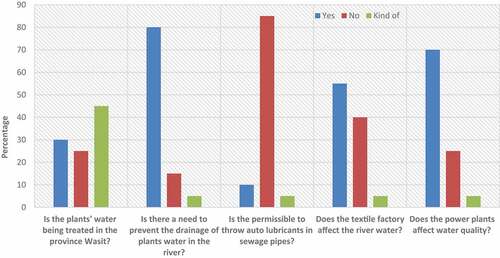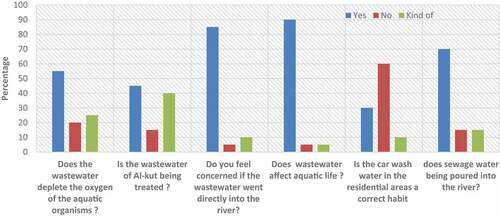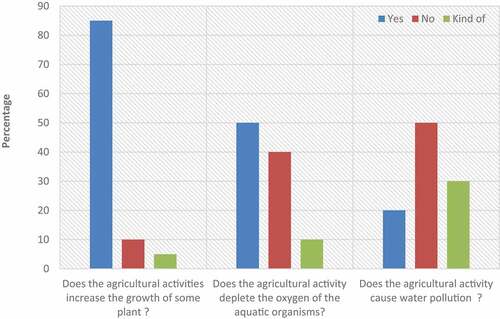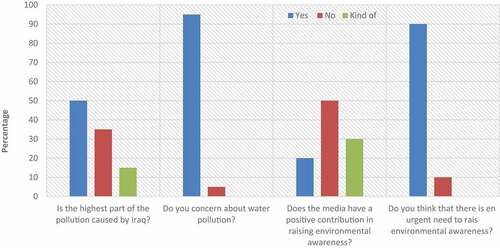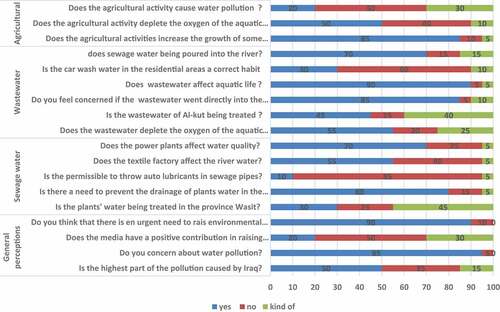Abstract
This study intends to evaluate university students’ awareness regarding water pollution in Iraq to show the environmental education contribution in reducing water pollution. The study was conducted in Wasit university, Wasit province, Iraq by field questionnaire survey with 388 students from the civil engineering department and engineering college. The questionnaires were divided according to the pollution causes into industrial, agricultural and sewage water pollutants. The data were analyzed utilizing the thematic analysis to assess environmental knowledge and awareness of water pollution risks. The results show that most students have high interest in environmental conservation, yet, a lack of education in general environmental education, as the educational curriculum focuses on theoretical aspects more than the practical ones. The results also show that the media role is inactive concerning environmental awareness of water pollution. This study provides a scientific view of policymakers for potential future conditions to find solutions that achieve sustainability goals.
PUBLIC INTEREST STATEMENT
The freshwater on the earth is about 3%. Furthermore, due to water pollution levels increment and climate change, this small percentage is decreasing. Since awareness of problems is the first step in the solution, this research aims to assess the environmental awareness for a conscious segment of the society which is university students, to find out the extent of their influence in reducing this problem.
1. Introduction
Water is an essential component contributing to continuing life on the earth planet, existing the cities and prosperity the industries (Khan et al., Citation2020). Accordingly, managing freshwater sources are a significant issue for policymakers under the impact of climatic and socio-economic factors (Yasin Osman et al., Citation2019). Climate change led to depletion widely potable water sources in the centre of cities. On another side, it increases the water demand (Fenu & Malloci, Citation2020; Zubaidi et al., Citation2018). Additionally, the United Nations’ outlook to 2050 indicates that the level of urbanization is anticipated to grow from (50–69) % based on 2009 as a baseline (Nahla Abbas et al., Citation2018).
Moreover, between 2010 and 2050, 40% of the global population may be under severe water shortage (Zubaidi et al., Citation2018). Developing countries faced a considerable challenge, which is maintaining and improving environmental quality to attain sustainability. Although these countries found laws and policies to control, monitor and reduce environmental pollution, they fail to enforce them to protect the environment. Additionally, in the developing countries, the water supply systems are inadequate and delivered low water quality that resulted from water demand increases rapidly and discharges the untreated wastewater direct to the freshwater sources (Awoke et al., Citation2016; Zulu et al., Citation2020). WHO, 2017 stated that municipal water supply system must deliver safe and clean water (i.e., water does not have living microorganisms or harmful chemical substances in concentrations more than the acceptable limit). On the other hand, UNEP, 2016 reported that urbanization and development growth contributed to extensively increasing contamination in freshwater sources (Selvakumar et al., Citation2017).
Water pollution has been in the centre of international attention because of detecting hazardous materials into water body worldwide, resulting from different climatic and socio-economic factors (Hasan et al., Citation2019). Freshwater sources with good quality represent a high priority to people, not only for potable water but also for tourism resources. The freshwater quality evaluation is significant for managing and developing freshwater sources to gain sustainability in this context. For this purpose, protecting the quality of water by collecting and treating the domestic and industrial wastewater is vital to the environment and human health in urban areas (Al-Mamoori & Al-Maliki, Citation2016; Kiguchi et al., Citation2016; Noorhosseini et al., Citation2017). Therefore, Paying attention to environmental awareness is essential in all societies, whether developed or developing. Many studies have been conducted regarding environmental education recently, for example, see Riordan, M. and E.J.J.T.E.Q. Klein (Riordan & Klein, Citation2010), Soto-Cruz, R., et al. (Soto-Cruz et al., Citation2015), Jadhav, A., et al. (Jadhav et al., Citation2014), Onder, S.J.J.o.A.S. (Onder, Citation2006), Oğuz, D., I. Çakcı, and S.J.T.O.D. Kavas (Oğuz et al., Citation2011), Freije, A.M., et al. (Freije et al., Citation2017), Bashir, M.J., et al. (Bashir et al., Citation2020) and Maffia, A.M.d.C., E. Silva, and L.A.G.J.A.S.B.S. Jacovine (Maffia et al., Citation2011).
Since Iraq is located in an arid to a semi-arid area that generally suffers from water scarcity, and is anticipated to grow in the future due to the influence of different factors including climate change (Nahla Abbas, Wasimi et al., Citation2016a; Nahlah Abbas, Wasimia et al., Citation2016b), pollution (Mohammad & Jassim, Citation2014; Sabreen et al., Citation2020) and a high rate of population growth. Iraq depends on the Tigris and Euphrates Rivers as the primary sources of potable water (Zubaidi et al., Citation2019; Zubaidi, Al-Bugharbee, Muhsin, Hashim, & Alkhaddar, 2020). Tigris river faced considerable water lacks from 2009 to 2014. These water lacks are anticipated to increase due to global warming and increasing water demand upstream (Turkey, Syria and Iran) (Al-Ansari et al., Citation2018; Chabuk et al., Citation2020; Mohammad & Jassim, Citation2014).
After 2014, Iraq faced terrorism, which attacked several dams that influenced water control in the rivers. Consequently, water shortage was increased, particularly in Iraq’s southern provinces, and Wasit is one of these provinces. The water quality and shortage problem adversely affect the environment, waterbody, the agricultural sector and economy (Aljanabi et al., Citation2018a, Citation2018b; Consuelo, Citation2020). Besides, Iraq faced the acute impact of climate change and is expected to worsen by increasing the temperature and reducing the rainfall (Yassin Osman et al., Citation2017). The implemented literature to assess the quality of Tigris River water referred to an increase in the presence of various pollutants (Abdulwahab & Rabee, Citation2015; Al-Obaidy et al., Citation2015; Omar, Citation2017). Hence, it became necessary to assess the level of awareness of water pollution and its impact on mitigates this problem.
This study explores university students’ awareness in Iraq as this kind of studies have not been conducted. Wasit Governorate was chosen as a case study, as it is one of the most important cities through which Tigris River passes and is one of the most important centres of industrial and agricultural activities. The fourth stage students in Civil Engineering College were selected as the study sample to assess their awareness of water pollution because they spent a long time at the university. Thus, the role of higher education in rising awareness can be evaluated. Moreover, this study could be a platform for studies in the future regarding this topic. The results should be very beneficial to the government to adopt mitigation plans to solve pollution problems.
First, the study area and the water resources available in it were identified. Also, the study population, its knowledge background and the reasons for choosing it, were discussed. Then, the water pollution sources that the study area suffers from are mainly discussed and based on which the questionnaires were formulated. After collecting the answers, the statistical methods were applied to obtain environmental awareness indicators. The research methodology flow chart is presented in .
2. Materials and methods
2.1. Study area
This study was conducted at the University of Wasit, Engineering Collage for nine months period of research. shows Wasit provenance location as the students who were chosen to conduct the study represent the provenance. The main water resource in Al-Kut city is the Tigris River. The length of the river reach in the city is 250 km controlled by Kut Barrage (Abbass Jasim et al., Citation2017)
2.2. Sampling and survey design
Most water resources pollutants result from factors within Iraq. So far, there was no response to this high pollution, be it on formal and informal levels. Additionally, no punitive actions or enforceable laws were adopted to fit the significant damage, knowing that the research is still attempting to fill the gaps in the definition of the problem by justifying the reasons for the absence of the response. The study is trying to inquire about the awareness of water pollution of an essential and very aware segment compared to other sectors. This inquiry aims to determine students’ perception of different pollutants and contaminants in the local water environment to reduce water pollution. The lack of awareness of water resources in Iraq harmed water pollution and to its optimal investment.
The study population may be identified as all the Civil Engineering Department students at the Faculty of Engineering, the University of Wasit totalling 388 students distributed on fourth stages students. The selected students take a compulsory course for designing water networks and another compulsory course in designing irrigation and drainage networks. However, no environmental course is available during the four years of their study.
2.3. Water pollution and environmental awareness
Environmental awareness aims to acquire and promote environmental protection values. Education and public collaboration may improve the environment quality by enhancing the students’ basic knowledge. thus, increasing their environmental awareness of the natural resources of the watershed in which they live (Athman & Monroe, Citation2001)
During the seventies of the last century, the environment issue was handled by small groups of scientists and experts into a general political problem. This problem requires significant knowledge and action by the state, the private sector, the civil society and the public. The research results must be translated into clear policies to be followed by the state and the leaders of the private sector and civil society and community members. Environmental awareness must become a way of living and integrated into our consciousness, values and everyday actions. It should be reflected in the planning and work in all civil society sectors, the private industry and the state. It requires a new ideology and perhaps a further reading of our moral and spiritual heritage to adapt to life’s survival on earth.
2.4. Water pollution sources
Water is essential as oxygen to humans; therefore, it should be reasonably pure. Otherwise, humans will be seriously harmed. However, unfortunately, the water’s purity is almost impossible, considering the many pollutants in the environment. Besides, many people do not know that water is connected to living beings; thus, water contamination is also linked to living beings. Undoubtedly, water pollution constitutes a severe problem that is no less dangerous than air pollution since they are common in the pattern of pollution prevailing in third-world countries. However, since water is a significant element in an individual’s life, here lies the importance of preserving it and preventing the spread of dangerous diseases.
There were no concerns about water pollution in the past. There was a belief that rivers, lakes and oceans are the best place for dumping waste disposal and these are the same sources of drinking water (Islam, Citation1990). Human activities, industrial and agricultural growth, and social communities involve several negative influences reflected in nature’s water cycle. It starts from the water evaporation stage from the ground and ends by returning to that loaded with various contaminants. Nature may have a decisive role in improving several cases of water pollution, where it contributes to removing or reducing the number of pollutants caused by humans. However, this natural weapon is weak and is getting more vulnerable with the increasing industrial growth and the highly concentrated pollutants emitted in the necessary environmental elements (air—water—soil).
The fresh potable water constitutes only 0.7% of rivers, lakes, underground water and water vapour in the air. If this light percentage of pure potable water is distributed according to the population distribution on earth, it will cover humans’ needs; however, there is no fair distribution of natural resources. For example, we find that the number of rainfalls in tropical regions reaches several meters while almost nonexistent in some desert areas. The imbalance demonstrated in the Amazon basin, which intakes 20% of fresh groundwater while inhabiting a meagre percentage of the world population (Paramanik, Citation2018). The primary sources of water pollution are the Industrial sources, Sewage sources and Agricultural sources. presents the water used annually by sector in iraq.
Figure 3. Annual water use by sector in Iraq [https://water.fanack.com/iraq/water-uses-in-iraq\]
![Figure 3. Annual water use by sector in Iraq [https://water.fanack.com/iraq/water-uses-in-iraq\]](/cms/asset/b20f096d-d340-4dd1-88ce-5521f5c264ac/oaen_a_1895473_f0003_oc.jpg)
2.4.1. Industrial sources
Plants water and droppings form 60% of the total contaminated materials in seas, lakes and rivers. Most pollutants are dropped from factories such as tanning, lead, mercury, copper, nickel, paint, cement, glass, detergents, dairy sterilization, slaughterhouses and sugar refining factories. In addition to the pollution caused by the hydrocarbon resulting from oil pollution and the thermal pollution resulting from the high-water temperature used for cooling engines, machines plants and nuclear reactors. This rise in the water temperature reduces the amount of oxygen therein, which will be reflected negatively on all organisms living in this water area, which loses its natural balance (Pennington & Cech, Citation2009).
Most of the factories in developing countries and even developed countries do not adhere to industrial waste regulations; instead, they drop their water waste. It should be noted that the traditional methods of water purification do not eliminate the industrial pollutants (like hydrocarbons) inorganic contaminants, pesticides and other various chemicals. Besides, the chlorine used in water purification reacts with hydrocarbons, forming carcinogen carbohydrate chlorine materials. One of the forms of industrial pollution is when some factories and power plants use rivers and lakes water in the cooling process, resulting in the rise of water temperature, which negatively affects water and aquaculture’s biochemical reactions. Factory residues are considered one of the largest sources of pollution in rivers, seas and oceans. These residues contain many toxic chemicals discharged into the water surfaces such as rivers, seas, or agricultural drains sewage systems. The different chemicals depend on existing industries types and the type of processing in each plant. However, most factories drop many materials such as acids, bases, detergents, dyes, certain phosphorus compounds and heavy toxic metals such as lead and mercury causing severe pollution to the water they are dropped.
2.4.2. Sewage sources
Sewage is considered one of the most acute problems of public health in many third world countries. Since most of these countries (including Iraq) do not have an integrated sewerage system, some big cities do not have a sanitation network. The problem occurs when the towns drop sewage water in the river’s course without treatment, thereby causing a severe health problem. Moreover, septic tanks in places where there is no sewage network will harm public health, mostly if these are left exposed, or their waste is dumped in the vicinity of houses, where the breeding of mosquitoes and flies cause many diseases. In addition to pesticides use that would hurt human health.
Sewage water contains a large amount of organic material and vast numbers of aerobic and anaerobic microorganisms. When it reaches the surface water, the aerobic organisms consume the oxygen to degrade the natural materials, and thus causes a shortage of oxygen, leading to suffocation and death of the marine organisms. After their departure, the bacteria or anaerobic micro-organisms begin their degradation, creating a rot and spoil state.
Wastewater consists of water used at home, whether in bathrooms or kitchens, and the water used in some workshops, small factories and fuel stations located within the city.
Wastewater contains a high percentage of water, 99.9%, and the remaining are solid, colloidal and dissolved materials. The following pollutants characterize wastewater:
1- The presence of toxic substances, such as lead, nickel, mercury, chromium, cobalt, cadmium in high concentrations above the permitted international rates. These substances are originated from industrial wastewater and are precipitated in the soil up to the plant and then animals and humans. And cause many diseases that harm human health.
2- The presence of many harmful bacteria to humans and animals at high rates exceeding hundreds of millions of coliform groups, which are the primary source of intestinal diseases. as well as the salmonella bacteria which cause typhoid, gastroenteritis fever and the Shigella bacteria which causes diarrhoea.
3- Parasites eggs presence that cause many diseases such as bilharzia, hookworms, Ascaris and liver worms. As well as the presence of eggs that cause illness to cattle then transmitted to humans such as tiniasuliom and toniasagiinata.
4- The presence of fungal, bacterial and insects’ pesticides, herbicides, phosphorus compounds, chlorides toxic, industrial, mineral and organic detergents.
5- The presence of high levels of humidity in the sludge accompanying this water over 95% increases their disposition or re-usage to take advantage from there since they contain a high percentage of the necessary elements for plants improve the soil fertility.
2.4.3. Agricultural sources
The use of pesticides and chemical fertilizers in agriculture increased recently. They were part of these substances’ drifts with rainwater and irrigation to reach the surface and groundwater and causes severe chemical contamination of water sources. This contamination occurs either directly by throwing them into the water or indirectly through wastewater, industrial wastewater and agricultural wastewater poured into these surfaces. Part of these pesticides leak into the groundwater (Brunner & Kinzelbach, Citation2006).
The term “pesticides” refers to any chemical substance used to resist insects or fungal or herbal pests. Pesticides divided into fungicides and herbicides. The environmental damage caused by these pesticides is due to the slight dissoluble compounds containing highly toxic heavy elements. The outputs of their dissolution increase the concentration and accumulation of chloride, phosphorous and nitrates above the allowable limit in the agricultural environment, including animals and humans. The pollution of ground and surface water from pesticides is due to the inappropriate trading of these chemicals with environmental impacts and the accidents in agriculture, industry and trade (Ali. Mokdad Hussein; Dokić et al., Citation2020).
The other type of pollution is the result of throwing drainage water in rivers.(Mohammad & Jassim, Citation2014) As a result, this will increase the salinity of the water and another type of pollution accompanying the drainage water, resulting from excessive use of fertilizers, which finally merges with drainage water and contaminate rivers (Al-Mamoori & Al-Maliki, Citation2016). The throwing of chemical nutrients (Alozoto, phosphorus and potassium) in basins, rivers and other waterways leads to algae’s dense growth. The occurrence of the water enrichment phenomenon is characterized by premature ageing of the water system. The colour, taste and texture of this enriched aqueous medium changes and its proportion of oxygen lessen. Chemically contaminated water causes several diseases such as cancer, abdominal diseases, cardiac and eyes disease, and others (Madramootoo et al., Citation1997).
3. Environmental awareness and university education
The interest in environmental issues is growing day after day due to humanity’s severe challenges. The lack of ecological awareness is diagnosed as one of the factors affecting the environment’s low quality. However, in order to improve the environment, we need to publish, disseminate and deepen the environmental knowledge among the human societies by pushing and motivating them to participate and contribute to the improvement of the environment and reduction of the potential risks from the harmful environmental behaviours, also to solve limited problems of the human environment by helping people to recognize these problems.
The environmental awareness programs target the social groups with their various cultural, economic and social segments and considerations reaching the individual’s preparation to play an influential role in improving the environment. The individual, family and community play essential functions in activating the concepts of environmental awareness and achieving the acceptable ecological and health levels and setting the suitable foundations for their development and upgrade in the anticipated future. The father and the mother at home constitute the basis of establishing the environmental concepts among young people through the early awareness of environmental risks and creating a mental readiness to prevent them their occurrence (Tiong et al., Citation2020). The second step is the school; the educational curricula have a significant impact. The academic curricula can be employed as a station to prepare the coming generations. These can include healthy environment awareness signals and open the fields to expand the student’s interests in environmental issues and incite him to take the environmental issues as a personal and daily concern. Then, support him in becoming a literate ecological activist that requires applying the other social institutions’ theoretical achievement and activation to play a parallel role in achieving the same goals.
The different media institutions such as the radio, television, newspapers, periodicals and the Internet are growing with the available broad recipient audience from all age groups. These institutions could play the school’s role if part of their capacities and times were employed in environmental health awareness by addressing the majority of the audience in the purest forms of presentation. Considering the cultural and educational levels of these groups and providing simple, light and entertaining types and examples of the positive and negative environmental behaviour within the scope of the current cultural context.
All of these efforts unite to reach the concept of environmental citizenship which focuses on finding a self-deterrent deriving from the inner self and pushing the man to protect, maintain and respect the environment, and this is the essence of environmental citizenship (Činčera et al., Citation2020). It is now clear that universities play an essential and critical role in developing human societies. Making their present and plan their future landmarks, considering it as an intellectual and technical base of the human communities by the collection and preservation of knowledge and the formation of good trends through dialogue, interaction and generation of knowledge and work on their progress. The education process is considered one of the university’s functions to contribute to the complete and comprehensive development of individuals, i.e., to enable the university to perform its human resource development function.
The university performs scientific research through its faculties and various research centres, with the professors who consider scientific research an essential aspect of their functional responsibility. In this context, university students, especially graduate students, carry out scientific research in various areas under their professors’ guidance and supervision. Many examples illustrate university research’s function in the field of environment protection and responding to its problems (Vaishali et al., Citation2019). To understand these problems correctly, the environment should be one of the interconnections between the widespread phenomena and conditions, which was tending to be separated by one of the followers of an approach based on one scientific discipline. The approach gathering several disciplines ignores the boundaries between the specialized sciences. It is more concerned in giving a comprehensive and non-simplistic view to the existing problems since it is not represented first inputting the different sciences together and understanding the process comprehensively before analyzing and solving one of the problems. The reach for several scientific branches’ collective education constitutes a problematic requirement that we should gradually achieve.
The individuals and groups are not concerned about the quality of the environment. They are not moving to protect or improve it resolutely. Therefore, the collective approach is essential because apparently, much of what is called national problems are nothing but the outcomes of individual problems despite common between several local communities. Simultaneously, if it were possible to resolve a local community’s specific problems, then we would have passed a long way towards improving the environment for the favour of a broader community, such as a country or region. On the other hand, improving the environment’s quality requires the provision of the necessary political administration. The efforts of various social sectors extended to support its competencies and several means. The actual integration between knowledge capabilities and other elements, such as values, aesthetic outlook and practical skills, as well as the participation of individuals within the various groups and utilities that form the community, will all lead to understanding the environment and rationalizing its management and improvement (Hungerford et al., Citation1980; Othman et al., Citation2019).
The environmental awareness aims to educate the man that he is an influential living being in the environmental and integral parts. The excellent exploitation of the environment while maintaining it, relies on the quality of man’s activity and his relation to the environmental entity. As long as man is the crucial element in environmental pollution taking place on the earth’s surface, he can also be an essential and useful element in protecting and developing this environment on earth (Thomson et al., Citation2003).
4. Results and discussion
4.1. The awareness of industrial pollution sources
The questionnaire results revealed the presence of high-impact industrial sources of water pollution in general. It showed a negative impact of 70% from power plants on water pollution, while only 5% showed no effect. It also revealed 85% of negative impact from throwing grease residues in sewage pipes. The questionnaire also showed 80% of the need to prevent throwing industrial water in the river and punish the violators. In comparison, only 5% replied that there are no problems from throwing industrial water in the rivers. However, on the other hand, the awareness of rivers pollution in the local environment was lesser. Upon questioning the impact of wastewater from the Kut textile factory, 55% replied that it affects the river water; while 40% answered no effect. Upon questioning the industrial water treatment before throwing in the river, 30% replied that treatment. In comparison, 25% responded that there is no treatment, knowing that most industrial water is not processed. The results are presented in and .
Table 1. The questionnaire answers percentage of industrial pollution sources
4.2. The awareness of sewage pollution sources
The questionnaire results showed weakness in the knowledge of water pollution in the local environment. Only 45% answered that wastewater in Al-Kut is being processed, 40% answered that there is a type of treatment. In comparison, 15% answered that there is a treatment, noting that the wastewater throughout Wasit province is not undergoing any treatment in Wasit province, and is being directly drained into the rivers. A high percentage of students (70%) answered that the wastewater goes into the river, while 15% answered that it does not go into the river. On the other hand, the awareness of water pollution as a result of wastewater, in general, was excellent; 90% indicated that wastewater affects the aquatic organisms while 5% indicated that they are not affected. Also, 60% answered that car wash water is drained in residential neighbourhoods, while 30% indicated that car wash water does not affect the water pollution.
Additionally, 85% showed concern on the water drained directly into the river, while 5% showed no concerns, 55% indicated that the wastewater depletes the oxygen necessary to aquatic organisms, while 20% indicated no effect. Upon asking about the impact on the biodiversity, 60% indicated the impact of wastewater on biodiversity, while 25% reported no impact. The results are presented in and .
Table 2. The questionnaire answers percentage of sewage pollution sources
4.3. The awareness of agricultural pollution sources
The awareness of water pollution from the agricultural resources was the least. 50% answered that there is no negative impact on agricultural activities, while 20% answered yes. 50% replied about the effect of the residues of agricultural activities on aquatic organisms. In comparison, 40% pointed out that there is no effect. The awareness of the impact of agricultural activities on the biological balance and the increasing growth of some plants was the largest. 85% said that there is an impact, and only 10% said no impact. The results are presented in and .
Table 3. The questionnaire answers percentage of agricultural pollution sources
4.4. The awareness of water pollution in general
There is excellent awareness of the real cause of water pollution by the students in Iraq. 50% replied that Iraq causes the highest part of the pollution. The student’s water pollution concern was 95%, where they answered that the concern should be sometimes permanent. There is the awareness that the social factor requires attention to water pollution. In comparison, only 5% had a negative answer to this question. The role of the media and the Non-Governmental Organizations (NGOs) is inactive in spreading environmental education about water pollution, where only 20% indicated the role of these actors in raising awareness. 90% of the students also believed that there is an urgent need to educate people about water pollution to reduce pollution. The results are presented in and .
Table 4. The questionnaire answers percentage of water pollution in general
Environmental education aims to promote students’ knowledge of environmental degradation causes and how to preserve it by applying the scientific concept. However, students themselves need to have a clear understanding of the water pollution sources to solve these issues.
The results show that most students have high interest in environmental conservation, yet, a lack of education in general environmental education, as the educational curriculum focuses on theoretical aspects more than the practical ones. The results also show that the media role is inactive concerning environmental awareness of water pollution. The selected population should be more aware of the environmental issues as they had been in the university for 4 years. Therefore, more efforts must be made to raise awareness of these problems through seminars and volunteer work, in addition to directing the media to draw attention and spread awareness regarding water pollution. To compare the population answers and identify the most frequent defects, the stacked Pareto Chart is presented in .
All the positive answers are presented in and sorted in ascending order to indicate the weakness by sector. It is clear that the university students are less aware about sewage pollutants in comparison to their general awareness.
5. Conclusion
Water resources pollution and its effects and the global water crises have grave consequences on communities’ health and safety, so, to solve environmental problems, they must be recognized and valued. This research aims to assess environmental awareness for a conscious segment of Iraqi society, the university students. N. Yildiz et al. emphasized the importance of raising awareness and informing people to solve environmental issues (Yildiz et al., Citation2011). The questionnaire addressed three pollutants of water resources, agricultural, industrial and sewage as the main pollution causes. The results showed that the selected population lacks precise environmental awareness of water pollution in their local community despite their general theoretical knowledge. 40% of the population indicated that Al-Kut textile factory wastes would not pollute the water, and 30% said that the factory treats its water before throwing it into the river; however, the water actually is not treated. The same thing applies to household waste, as 85% answered that there is a partial or total treatment when there is no treatment for household wastes so far. As for pollution from agricultural sources, 75% of the sample answered no negative impact of water pollution by agricultural activities. This indicates a significant weakness in awareness of the damage caused by agricultural activity and the pollutants that negatively affect the aquatic environment. The results indicate a lack of education in general and environmental education, as education focuses on theoretical aspects more than the practical ones. Water resources pollution is one of the most challenging environmental problems due to its impact on societies’ security, especially developing ones. Hence, if the university students were knowledgeable and become involved in environmental issues through being taught about water pollution, they could potentially make a great impact. Consequently, the research recommends adopting compulsory environmental courses for university students to reinforce the idea of sustainable development.
Informed consent statement
Not applicable.
Conflicts of Interest
The authors declare no conflict of interest of any kind
Code availability
Not applicable
Availability of data and material
Not applicable.
Additional information
Funding
Notes on contributors

Laheab A. Al-Maliki
Laheab A. ALMALIKI: Researcher, academic and civil engineer specialized in water resources. Holds a Master Degree since 2013. She had published several scientific papers in journals, conferences and seminars in civil engineering field, and still working on others. She currently works as a lecturer at Al-Qasim Green University.
References
- Abbas, N., Wasimi, S., Al-Ansari, N., & Sultana, N. (2018). Water resources problems of Iraq: Climate change adaptation and mitigation. Journal of Environmental Hydrology, 26. https://www.diva-portal.org/smash/record.jsf?pid=diva2%3A1206419
- Abbas, N., Wasimi, S. A., & Al-Ansari, N. (2016a). Impacts of climate change on water resources in Diyala River Basin, Iraq. Journal of Civil Engineering and Architecture, 10(9), 1059–17. https://doi.org/10.17265/1934-7359/2016.09.009
- Abbas, N., Wasimia, S. A., & Al-Ansari, N. (2016b). Assessment of climate change impacts on water resources of Al-Adhaim, Iraq using SWAT model. Engineering, 8(10), 716–732. http://dx.doi.org/10.4236/eng.2016.810065
- Abbass Jasim, I., Lafta Farhan, S., & Al-mamoori, K. (2017). Smart government: Analysis of shift methods in municipal services delivery: The study area: Al-Kut – Iraq. Journal of Kerbala University, 13(3), 1–15. https://kj.uokerbala.edu.iq/article_132033_21676d91009d651203e34fdb35f21a9b.pdf
- Abdulwahab, S., & Rabee, A. M. (2015). Ecological factors affecting the distribution of the zooplankton community in the Tigris River at Baghdad region, Iraq. The Egyptian Journal of Aquatic Research, 41(2), 187–196. https://doi.org/10.1016/j.ejar.2015.03.003
- Al-Ansari, N., Adamo, N., Knutsson, S., & Laue, J. (2018). Geopolitics of the Tigris and Euphrates Basins. Journal of Earth Sciences and Geotechnical Engineering, 8(3), 187–222. http://urn.kb.se/resolve?urn=urn%3Anbn%3Ase%3Altu%3Adiva-68451
- Aljanabi, A. A., Mays, L. W., & Fox, P. (2018a). Application of an optimization model for assessing the performance of water appropriation in Iraq. Environment and Natural Resources Research, 8(1), 105. https://doi.org/10.5539/enrr.v8n1p105
- Aljanabi, A. A., Mays, L. W., & Fox, P. (2018b). A reclaimed wastewater allocation optimization model for agricultural irrigation. Environment and Natural Resources Research, 8(2), 55. https://doi.org/10.5539/enrr.v8n2p55
- Al-Mamoori, S. K., & Al-Maliki, L. A. (2016). Evaluation of suitability of drainage water of al-hussainia sector (kut Iraq) to irrigate cotton crop. Kufa Journal of Engineering, 7(1), 67–78. https://www.researchgate.net/publication/322554834_EVALUATION_OF_SUITABILITY_OF_DRAINAGE_WATER_OF_AL-HUSSAINIA_SECTOR_KUT_IRAQ_TO_IRRIGATE_COTTON_CROP
- Al-Obaidy, A.-H. M., Al-Janabi, Z. Z., & Shakir, E. (2015). Assessment of water quality of Tigris River within Baghdad city. Mesopotamia Environmental Journal, 1(3), 90–98. https://www.iasj.net/iasj/download/3af7a589e6552801
- Athman, J. A., & Monroe, M. C. (2001). Elements of effective environmental education programs, Educational Resources Information Center (ERIC). https://files.eric.ed.gov/fulltext/ED463936.pdf
- Awoke, A., Beyene, A., Kloos, H., Goethals, P. L., & Triest, L. (2016). River water pollution status and water policy scenario in Ethiopia: Raising awareness for better implementation in developing countries. Environmental Management, 58(4), 694–706. https://doi.org/10.1007/s00267-016-0734-y
- Bashir, M. J., Jun, Y. Z., Yi, L. J., Abushammala, M. F., Amr, S. S. A., & Pratt, L. M. J. (2020). Appraisal of student’s awareness and practices on waste management and recycling in the Malaysian University’s student hostel area. Journal of Material Cycles Waste Management,22(3), 916-927. https://doi.org/10.1007/s10163-020-00988-6
- Brunner, P., & Kinzelbach, W. J. E. O. H. S. (2006). Sustainable groundwater management. Encyclopedia of Hydrological Sciences. https://doi.org/10.1002/0470848944
- Chabuk, A., Al-Madhlom, Q., Al-Maliki, A., Al-Ansari, N., Hussain, H. M., & Laue, J. (2020). Water quality assessment along Tigris River (Iraq) using water quality index (WQI) and GIS software. Arabian Journal of Geosciences, 13(14), 1–23. https://doi.org/10.1007/s12517-020-05575-5
- Činčera, J., Romero-Ariza, M., Zabic, M., Kalaitzidaki, M., & Bedmar, M. D. C. D. (2020). Environmental citizenship in primary formal education. In Mueller, Michael P., Tippins, Deborah J. Conceptualizing Environmental Citizenship for 21st Century Education (pp. 163–177). Springer. ISSN: 2352-7307. https://doi.org/10.1007/978-3-030-20249-1_11
- Consuelo, N. (2020). Advanced design for manufacturing of integrated sustainability “Off-Shore” and “Off-Site” Prototype-MVP “S2_HOME”. Civil Engineering Journal, 6(9), 1752–1764. https://doi.org/10.28991/cej-2020-03091580
- Dokić, D., Gavran, M., Gregić, M., & Gantner, V. (2020). The impact of trade balance of agri-food products on the state’s ability to withstand the crisis. HighTech and Innovation Journal, 1(3), 107–111. https://doi.org/10.28991/HIJ-2020-01-03-02
- Fenu, G., & Malloci, F. M. (2020). DSS LANDS: A decision support system for agriculture in Sardinia. HighTech and Innovation Journal, 1(3), 129–135. https://doi.org/10.28991/HIJ-2020-01-03-05
- Freije, A. M., Hussain, T., & Salman, E. A. J. (2017). Global warming awareness among the University of Bahrain science students.. Journal of the Association of Arab Universities for Basic Applied Sciences, 22(1), 9–16. https://doi.org/10.1016/j.jaubas.2016.02.002
- Hasan, M. K., Shahriar, A., & Jim, K. U. (2019). Water pollution in Bangladesh and its impact on public health. Heliyon, 5(8), e02145. https://doi.org/10.1016/j.heliyon.2019.e02145
- Hungerford, H., Peyton, R. B., & Wilke, R. J. (1980). Goals for curriculum development in environmental education. The Journal of Environmental Education, 11(3), 42–47. https://doi.org/10.1080/00958964.1980.9941381
- Islam, A. M. (1990). Pollution: The problem of the Era: National council for culture, arts and letters - Kuwait.
- Jadhav, A., Jadhav, V., & Raut, P. J. (2014). Role of higher education institutions in environmental conservation and sustainable development: A case study of Shivaji University, Maharashtra, India. Journal of Environment Earth Science, 4(5), 30–34. https://www.iiste.org/Journals/index.php/JEES/article/view/11624
- Khan, U., Haque, M. I., & Khan, A. M. (2020). Environmental sustainability awareness in the Kingdom of Saudi Arabia. The Journal of Asian Finance, Economics, and Business, 7(9), 687–695. https://doi.org/10.13106/jafeb.2020.vol7.no9.687
- Kiguchi, O., Sato, G., & Kobayashi, T. (2016). Source-specific sewage pollution detection in urban river waters using pharmaceuticals and personal care products as molecular indicators. Environmental Science and Pollution Research, 23(22), 22513–22529. https://doi.org/10.1007/s11356-016-7437-z
- Madramootoo, C. A., Johnston, W. R., & Willardson, L. S. (1997). Management of agricultural drainage water quality, (Vol. 13). Food & Agriculture Org. Book.
- Maffia, A. M. D. C., Silva, E., & Jacovine, L. A. G. J. (2011). Environment and environmental awareness: How university students conceive and act. Acta Scientiarum: Biological Sciences, 33(2), 209-214. https://www.redalyc.org/pdf/1871/187118578012.pdf
- Mohammad, O. I. A. L. A., & Jassim, L. A. (2014). Evaluation of suitability of drainage water of Al-Hussainia sector (Kut-Iraq) for irrigation. Wasit Journal of Engineering Sciences, 2(1), 30–45. https://doi.org/10.31185/ejuow.Vol2.Iss1.22
- Noorhosseini, S. A., Allahyari, M. S., Damalas, C. A., & Moghaddam, S. S. (2017). RETRACTED: Public environmental awareness of water pollution from urban growth: The case of Zarjub and Goharrud rivers in Rasht. Elsevier. https://doi.org/10.1016/j.scitotenv.2017.05.128
- Oğuz, D., Çakcı, I., & Kavas, S. J. (2011). Environmental awareness of students in higher education. Türkiye Ormancilik Dergisi, 12(1), 34–39. https://dergipark.org.tr/en/download/article-file/195770
- Omar, K. A. (2017). Prediction of dissolved oxygen in Tigris River by water temperature and biological oxygen demand using Artificial Neural Networks (ANNs). Journal of Duhok University, 20, 691–700. https://doi.org/10.26682/sjuod.2017.20.1.60
- Onder, S. J. (2006). A survey of awareness and behaviour in regard to environmental issues among Selcuk university students in Konya, Turkey. Journal of Applied Sciences, 6(2), 347–352. https://doi.org/10.3923/jas.2006.347.352
- Osman, Y., Abdellatif, M., Al-Ansari, N., Knutsson, S., & Jawad, S. (2017). Climate change and future precipitation in an arid environment of the MIDDLE EAST: CASE study of Iraq. Journal of Environmental Hydrology, 25(3), ISSN 1058-3912. https://researchonline.ljmu.ac.uk/id/eprint/5465
- Osman, Y., Al-Ansari, N., & Abdellatif, M. (2019). Climate change model as a decision support tool for water resources management in northern Iraq: A case study of Greater Zab River. Journal of Water and Climate Change, 10(1), 197–209. https://doi.org/10.2166/wcc.2017.083
- Othman, N. Y., Abd Saleh, Z., & Omran, Z. A. (2019). Development of stage-distance-discharge relationship and rating curve using least square method. Civil Eng J, 5(9), 1959–1969. http://dx.doi.org/10.28991/cej-2019-03091385
- Paramanik, A. (2018). Environmental education and environmental capital development at school level: Case study on Sikkim. Environmental Education, 3(8), 527-530. https://rrjournals.com/wp-content/uploads/2018/08/527-530_RRIJM18030896.pdf
- Pennington, K. L., & Cech, T. V. (2009). Introduction to water resources and environmental issues. Cambridge University Press.Book.
- Riordan, M., & Klein, E. J. J. (2010). Environmental education in action: How expeditionary learning schools support classroom teachers in tackling issues of sustainability. Teacher Education Quarterly, 37(4), 119–137. https://www.jstor.org/stable/23479463
- Sabreen, L. K., Al-Mamoori, S. K., Al-maliki, L. A., AL-Dulaimi, M. Q., & Al-ansari, N. (2020). OPTIMUM LOCATION FOR LANDFILLS LANDFILL SITE SELECTION USING GIS TECHNIQUE: AL-NAJA CITY AS A CASE STUDY. Cogent Engineering, 8(1), 1-17. https://doi.org/10.1080/23311916.2020.1863171
- Selvakumar, S., Chandrasekar, N., & Kumar, G. (2017). Hydrogeochemical characteristics and groundwater contamination in the rapid urban development areas of Coimbatore, India. Water Resources and Industry, 17(June), 26–33. https://doi.org/10.1016/j.wri.2017.02.002
- Soto-Cruz, R., Lebgue-Keleng, T., Balderrama, S., Vélez-Sánchezverin, C., Aguilar-Palma, N., Viramontes-Olivas, O., & Durán, A. J. (2015). Environmental awareness of the young in a rural community in the Sierra Tarahumara, Chihuahua, Mexico. Journal of Education Practice, 5(4), 197–201. https://www.iiste.org/Journals/index.php/JEP/article/view/11365
- Thomson, G., Hoffman, J., & Staniforth, S. J. (2003). Measuring the success of environmental education programs. Ottawa: Canadian Parks Wilderness Society Sierra Club of Canada. https://www.abcee.org/sites/default/files/Measuring_the_Success_Sept_7_2010-1.pdf
- Tiong, C. S., Lean, Q. Y., Ming, L. C., Abdullah, A. H. B., Mahalingam, S. R., Arshad, K., & Hock, L. S. J. (2020). Knowledge, perceptions of risks, attitudes and practices of environmental health among university students in northern Malaysia. International Journal of Health Promotion Education, 59(1), 1–12. https://doi.org/10.1080/14635240.2019.1708776
- Vaishali, S., Priya, V. V., & Gayathri, R. J. (2019). Awareness on soil pollution among school students. Drug Invention Today, 11(8), 1971-1975. https://jprsolutions.info/files/final-file-5d5f80a591d306.65802266.pdf
- Yildiz, N. D., Yilmaz, H., & Demir, M. (2011). Effects of personal characteristics on environmental awareness; a questionnaire survey with university campus people in a developing country, Turkey. Scientific Research and Essays, 6(2), 332–340. https://doi.org/10.5897/SRE10.719
- Zubaidi, S. L., Al-Bugharbee, H., Muhsen, Y. R., Hashim, K., Alkhaddar, R. M., & Hmeesh, W. H. (2019). The prediction of municipal water demand in Iraq: A case study of Baghdad Governorate. Paper presented at the 2019 12th International Conference on Developments in eSystems Engineering (DeSE). Kazan, Russia (194). https://doi.org/10.1109/DeSE.2019.00058
- Zubaidi, S. L., Dooley, J., Alkhaddar, R. M., Abdellatif, M., Al-Bugharbee, H., & Ortega-Martorell, S. (2018). A novel approach for predicting monthly water demand by combining singular spectrum analysis with neural networks. Journal of Hydrology, 561(June), 136–145. https://doi.org/10.1016/j.jhydrol.2018.03.047
- Zulu, K., Singh, R. P., & Shaba, F. A. (2020). Environmental and economic analysis of selected pavement preservation treatments. Civil Engineering Journal, 6(2), 210–224. http://dx.doi.org/10.28991/cej-2020-030914

